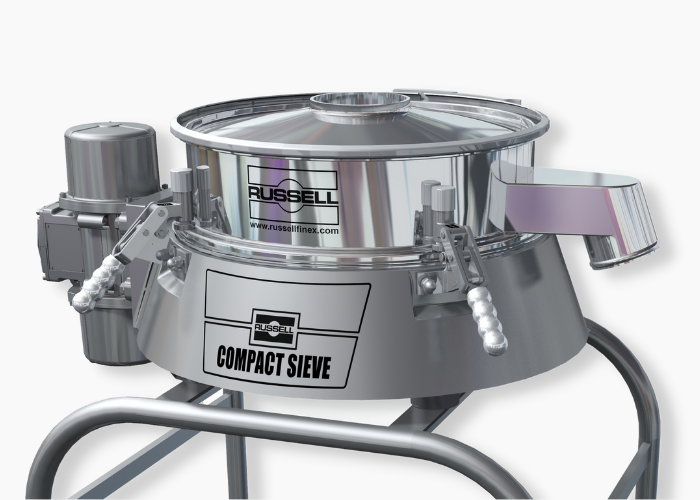The use of powder sieving today and how it has evolved through time
A brief history of powder sieving
Originating in Ancient Egypt to grade grain harvests, powder sieving has proven its usefulness throughout history to screen powders for consistent sizing, while eliminating contamination. This process is implemented across a range of industries today including pharmaceuticals, metallurgy, food and, more recently, 3D printing.
The sieve was first officially patented in the US by the Jacob Bromwell company in 1865. Hailed for its manufacturing innovation, the Jacob Bromwell’s flour sifter design is still a widely used kitchen appliance and remains a staple of baking today. The popularity of baking in the Victorian era is responsible for making powder sieving synonymous with flour sieving, even to this day. Anyone familiar with baking will understand the importance of sifting flour to eliminate lumps before measuring it- a basic practice that is universal when it comes to any powder handling.
Despite being centuries old, sieving is still a useful and reliable method to maintain particle size consistency, while also removing contaminants and unwanted materials from powders. In everyday life, it is still commonly used in cooking applications to separate and break up powders such as cocoa powder, powdered sugar and, of course, flour.

The industrial world of powder sieving
Today, powder sieving is an essential requirement across all industries, taking place across a number of production lines where it is used on an industrial scale. However, it has since evolved from a handheld tool to full-scale industrial machines, designed for modern production requirements. This innovation in technology has resulted in mechanical machines being used for large-scale production, with features such as vibratory motors to automate and optimize the process.
Industrial sieving is a versatile process as it can be implemented into different stages of powder production. For example, check screening can be used at the beginning or end of production to remove lumps and contaminants from powders, such as food products or additives, to improve their quality, while grading can be used to sort powders into different particle sizes.
Many global companies implement powder sieving into their production lines, including major companies like Heinz, Nestle, Pfizer, Merck, and Du Pont, each with their own powder products and production requirements. With sieving being a crucial process within numerous sectors, vibratory sieves are typically used in in the production of nearly every manufactured product in use today.
As well as sieving common powders like flour on a larger scale, industrial sieving has evolved over time to process a wide range of powders across several sectors; each with their own processing requirements. The metallurgical industry on its own has several different powders including solder powder, shotblast media and many more. Certain industries also have their own unique standards and requirements, such as the food and pharmaceutical industry, which must abide by specific hygiene standards to ensure the quality of their products.
Powder sieving remains prevalent in the global supply chain and continues to evolve thanks to modern innovation. Most recently, it has been used in additive manufacturing to protect the consistency and quality of AM powders used in 3D printing. Much like its common use in flour sifting, it is crucial to eliminate lumps and inconsistencies to ensure the quality of the final printed product.
Challenges of powder sieving today
Naturally, with a wide range of industries comes a range of powders, each with different properties in terms of size or coarseness and dryness. As such, companies need to select the appropriate mesh size depending on their sieving requirements. Historically, mesh sizes were measured by the number of holes contained per inch of a screen which is still the case to this day, now being measured in microns (μm). Powders can take the form of coatings, chocolate, pharmaceutical products, metal powders amongst many others, posing different challenges for different producers.
When sieving difficult powders, commonly present in pharmaceuticals and the metallurgical industry, powders can also block the sieve mesh, also known as mesh blinding. This is when the openings in a sieve mesh become clogged by screened material, causing trapped particles to build up and preventing further material from passing through. Not only does this affect production rates, but also risks damaging the mesh in the long run. To resolve this issue, a mesh needs to be vibrated to clear the blockage. Fortunately, there are now automated deblinding systems that employ the use of ultrasonic frequencies to accomplish this.
Production lines must also be aware of safety concerns including dust and even explosive hazards. For this reason, there are safety standards such as ATEX which aims to promote safety protocols that minimize explosion risks in a hazardous environment. Dust can also pose respiratory risks to operators within production lines which is why powder sieves can also be fully contained or pneumatically conveyed to avoid operator exposure altogether.
In the modern industrial age of sieving, its heritage is now successfully carried by companies like Russell Finex, one of the top sieving equipment manufacturers in the world. Staying true to its roots, sieving still fulfils the same basic function today, maintaining consistent particle sizes in powders, while eliminating any unwanted materials. From its humble beginnings processing grains and flour, powder sieving is now more important than ever for industries across the globe.
